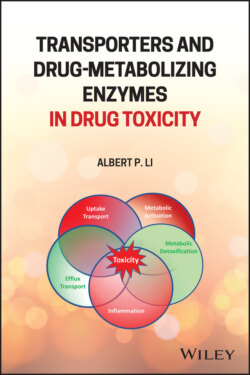Читать книгу Transporters and Drug-Metabolizing Enzymes in Drug Toxicity - Albert P. Li - Страница 98
3.14 Conclusions
ОглавлениеA review on the uptake, efflux, and metabolism of the 12 toxic drugs show that drug–drug interactions, metabolic activation, and BSEP inhibition represent the key mechanism of toxicity (Table 3.1). With our current extensive mechanistic understanding of metabolic enzyme and transporter induction and inhibition, and the resulting effective in vitro/in vivo experimental approaches, toxicity due to drug–drug interactions with prescription drugs can be effectively managed. The next frontier for toxicity resulting from drug‐interactions is health supplements which have not been systematically evaluated for drug interaction potential.
Table 3.1 A summary of the key mechanisms of drug‐induced toxicity for the 12 toxic drugs.
| Drug | Mechanism of drug‐induced toxicity | ||
|---|---|---|---|
| BSEP inhibition | Reactive metabolite formation | Metabolic drug interactions | |
| Acetaminophen | — | X | — |
| Cerivastatin | — | — | X |
| Felbamate | — | X | — |
| Flucloxacillin | — | X | — |
| Nefazodone | — | X | — |
| Obeticholic acid | X | — | — |
| Sitaxentan | — | X | — |
| Sorivudine | — | — | X |
| Tacrine | — | X | — |
| Terfenadine | — | — | X |
| Troglitazone | X | X | — |
| Trovafloxacin | — | X | — |
Toxicity affected by metabolic activation and detoxification remains challenging. The analysis of potential risk factors suggests that toxicity may be enhanced as a result of genetic and environmental factors that would lead to co‐occurrence of multiple events: (i) Increased body burden of the toxic drug due to enhanced absorption resulting from enhanced enteric uptake transport and/or decreased effux transport. (ii) Increased liver burden resulting from enhanced hepatic uptake transport and/or decreased efflux transport. (iii) Elevated toxic parent drug/metabolites due to enhanced metabolic activation and decreased metabolic detoxification. Severe drug toxicity resulting from the co‐occurrence of these multiple risk enhancing factors is the basis for the Multiple Determinant Hypothesis of idiosyncratic drug toxicity.
